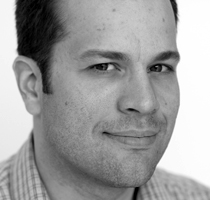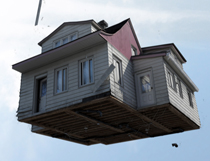P.I.: What was it like starting out as an artist and what is the biggest challenge so far?
G.B.: In the beginning, the most difficult task was to get a solo show either in a gallery or an artist’s centre. In my case, I was lucky and was able to exhibit at Skol, which is an artist centre in Montreal – that was in 2001 at the end of my bachelor’s degree. This gave me a big dose of confidence to continue. The challenge was to work outside the structure of academic (University) life and succeed in creating my place in the visual arts community in Quebec. A time period of 5 years elapsed between my undergraduate and Masters studies and that was a very productive period in which I relied constantly on my intuition and I focused all my efforts on producing works for various exhibitions. This period was very productive and rich in experience. But after five years, I felt the need to stop, to step back from my practice. Finishing the Master’s degree became an opportunity to observe my artistic practice, to question and understand. I wanted to identify this inner attitude and intervene in my ways of observing and producing. It became imperative for me to be able to clearly identify my creative process in its dynamics, in its concrete development. I wanted to use these self-discoveries about my work as a springboard to better cultivate my young artistic production.
P.I.: Your work so far has been restricted to photography, video and installation. Are you interested in exploring any other medium of art?
G.B.: In order to deepen my reflections on the status of the image, I wanted to continue my research on the use of 3D computer modelling in my work, which I started with the project ‘100, rue Blainville.’ Although one can see the great potential of this medium in the production of images in film and advertising, it is more hesitant as a medium in current practices of contemporary art. Yet this is an extremely powerful tool that confronts the very way we define an image. Technology has evolved and the people who use this medium have more and more control. It allows you to work as much with a fixed image as with an image that is moving, opens up new possibilities; it would be interesting to incorporate into an artistic practice, which has much different goals and viewpoints than commercial applications. The images produced with this medium, which are quite realistic, make the boundaries even more blurred between reality and what it seems to be. It can make any manipulation of the image more complex and adds a new dimension to the photographic image.
P.I.: Winning the Prix Pierre-Ayot prize landed you in good company with the likes of Michel de Broin, Raphaëlle de Groot and Nicolas Baier. Your work was also included in the well-respected 2008 Quebec triennial; has this benefitted your career in any way?
G.B.: The Pierre Ayot prize is really a very nice recognition in the visual arts community in Quebec. It was really an honour for me to end up on this list of Quebec artists I admire. This prize obviously gives credibility to your work. Maybe for art collectors or institutions interested in my work, this award corroborates their interest, and it certainly helped to promote some acquisitions. Regarding the Triennial, it was a magnificent exhibition that I am very proud to be part of. The exhibition was really beneficial to all artists, thanks to the visibility of the event. The critiques were glowing, and all the artists benefit from that. For my part, the Commissioners invited me to participate in various exhibitions following the Triennale (Vancouver, 2010, ICA, Portland, Oregon).
P.I.: Could you kindly share some details about Casser l’image (Fragmenting the Image)? For our readers, this is your recent exhibition curated by Yann Pocreau and co-produced by EXPRESSION, Centre d’exposition de Saint-Hyacinthe together with the Musée regional de Rimouski (Regional Museum of Rimouski). It is an ambitious body of work that has been described as a ten-year collection of retrospective art.
G.B.: This was actually the commissioner, Yann Pocreau’s idea. His intention was, in his words: “To consolidate a dozen recent projects by the artist retrospectively while keeping in mind what had attracted me to this work which is simplicity and efficient deconstruction of the image and structure.†He proposed the project for the Centre d’Expression in St-Hyacinthe and then at the Regional Museum of Rimouski. The exhibition also travelled to Moncton at the University Gallery there. We were luckily able to produce a beautiful catalogue with many colour illustrations and texts by Yann Pocreau, Bernard Lamarche and Melanie Boucher.
P.I.: In one of your several media release, you are quoted as describing your work as possessing what you term a bricoleur attitude. You go on to explain that this consists of playing with the limits of the perception we have of reality and its grey areas using graphic and photographic processes. I’m inclined to think of this statement as a curtailed and predictable analysis of your work. Could more be said perhaps for the manipulation of the natural laws of gravity and an insight into the matrix of objects in free-fall in some of your work? I’m referring to Grand Fatras to be specific.
G.B.: When I talk about my handyman attitude it is mostly to describe my creative process and my experimentation in the studio. In this sort of experimentation space, intuitions guide the selection of ingenious and creative manipulations, without one immediately worrying about the final result. It is not necessary to know in advance whether the test undertaken will generate a concept, an idea that will ultimately lead to a concrete project. Initiate a change first, then see what happens. With the intention of revising that which is common, changes call into question what we see and perceive. Exploiting the potential of objects means finding out what things are what we can make them say. Experimenting by manipulating and transforming the “object†is put into action by including the following: changing its appearance or integrity, placing it in a new context and testing its functions and characteristics. In the case of Grand Fatras, I wanted to test the experience of falling in an outdoor environment and with much larger objects. Of course, it took more preparation and logistics. So we rented a crane to launch objects. In my projects, there is always an element of the unknown, or things I cannot control. In Grand Fatras, it was difficult to accurately predict the fall and the impact of objects. Some objects hit the ground while others seem to float or to avoid it. This gives a strange feeling to photography. Later, I wanted to do projects that exploit only the time of impact. This brought to fruition the project Le Faux Movement (The False Movement) where you see dozens of mirrors that break at the same time in a large panoramic photograph. The challenge of this project was how to dose the spectacular effect of the breakage and yet maintain the mysterious or intriguing aspect of the image.















No Comments so far ↓
There are no comments yet...Kick things off by filling out the form below.